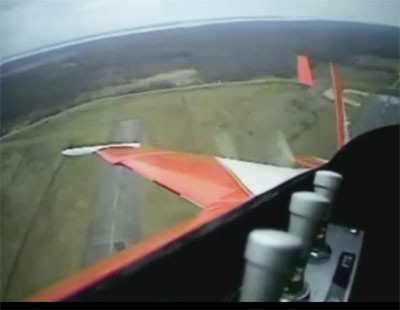Wed, May 30, 2007
Technology Holds Promise For Many Types Of Aircraft
Athena Technologies announced Wednesday the successful flight
demonstration of damage tolerant flight control and autonomous
landing capabilities on a subscale F/A-18 UAV. The Defense Advanced
Research Projects Agency (DARPA) sponsored the demonstration, which
was held on April 18, 2007 at the Aberdeen Proving Grounds in
Maryland.

The objective of the test was to prove that adaptive flight
controls could regain baseline aircraft performance after the
aircraft had sustained simulated battle damage and then safely land
the aircraft autonomously with only the onboard INS/GPS
functionality of Athena's GuideStar 111m for navigation.
The demonstration involved a subscale F/A-18 UAV, powered by a
turbojet engine, that sustained wing battle damage simulated with
the in-flight ejection of an aileron (shown above). Athena's damage
tolerant controls detected the damage in flight and adapted to the
new air vehicle configuration for the effects of the lost aileron,
recovering the baseline vehicle performance.
The vehicle then successfully landed in the damaged state with
Athena's INS/GPS-only autonomous landing system within a few feet
of the target touch down point on the airfield runway.
Damage tolerance is an enabling capability for increasing the
mission reliability of UAVs and Unmanned Combat Air Vehicles
(UCAVs) operating in hazardous and high-threat environments. The
technology provides for real-time autonomous accommodation of
damage, followed by an adaptation process that alters the flight
control system to compensate for the effects of the damage. During
the flight test, Athena demonstrated a capability that could be
applicable to all military aircraft operating in combat
environments. The technology is also relevant to any vehicle,
manned or unmanned, including civilian aircraft, that might sustain
physical damage or failures that impact controlled flight.
Athena tells ANN the demonstration highlights the challenge and
importance of the ability to autonomously land an air vehicle that
has sustained damage. This powerful capability can potentially save
the military the significant expense of lost UAVs and better
protect US proprietary technology.
More importantly, when applied to manned aircraft... the
combined technology solution could just save lives.
More News
Aero Linx: Model Aeronautical Association of Australia MAAA clubs are about fun flying, camaraderie and community. For over 75 years, the MAAA has been Australia’s largest fl>[...]
Touchdown Zone Lighting Two rows of transverse light bars located symmetrically about the runway centerline normally at 100 foot intervals. The basic system extends 3,000 feet alon>[...]
“Discovery and innovation are central to our mission at Virgin Galactic. We’re excited to build on our successful record of facilitating scientific experiments in subor>[...]
How To Get A Story On Aero-TV News/Feature Programming How do I submit a story idea or lead to Aero-TV? If you would like to submit a story idea or lead, please contact Jim Campbel>[...]
Student Pilot Reported That During Rotation, “All Of A Sudden The Back Of The Plane Kicked To The Right..." Analysis: The student pilot reported that during rotation, “>[...]
 ANN's Daily Aero-Linx (05.02.24)
ANN's Daily Aero-Linx (05.02.24) ANN's Daily Aero-Term (05.02.24): Touchdown Zone Lighting
ANN's Daily Aero-Term (05.02.24): Touchdown Zone Lighting Aero-News: Quote of the Day (05.02.24)
Aero-News: Quote of the Day (05.02.24) ANN FAQ: Contributing To Aero-TV
ANN FAQ: Contributing To Aero-TV NTSB Final Report: Cirrus Design Corp SR20
NTSB Final Report: Cirrus Design Corp SR20



